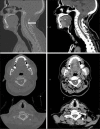Spinal arachnoiditis and syringomyelia: Review of literature with emphasis on postinfectious inflammation and treatment
- PMID: 35928312
- PMCID: PMC9345109
- DOI: 10.25259/SNI_383_2022
Spinal arachnoiditis and syringomyelia: Review of literature with emphasis on postinfectious inflammation and treatment
Abstract
Background: Arachnoiditis refers to chronic inflammation of the arachnoid mater and subarachnoid space due to three major etiologies: chemical, mechanical, and postinfectious. As a rare disease with variable symptomatology and severity at presentation, arachnoiditis can be extremely debilitating with many complications, prominent among which is syringomyelia.
Methods: We reviewed current literature concerning postinfectious spinal arachnoiditis and associated syringomyelia with emphasis on the treatment options that have been used to date and discuss their respective benefits and drawbacks.
Results: It is critical to understand the natural history and potential complications of patient with postinfectious arachnoiditis. Surgical and medical treatments both have their own merits and demerits. Different surgical approaches have been employed with variable success rates.
Conclusion: At present, no consensus exists regarding management of these patients due to the variable nature of the disease that affects treatment efficacy; however, surgical intervention in selected cases may be beneficial.
Keywords: Arachnoiditis; Meninges; Scarring; Shunt; Syringomyelia.
Copyright: © 2022 Surgical Neurology International.
Conflict of interest statement
There are no conflicts of interest.
Figures
Similar articles
-
Syringomyelia and spinal arachnoiditis resulting from aneurysmal subarachnoid hemorrhage: Report of two cases and review of the literature.J Craniovertebr Junction Spine. 2014 Jan;5(1):47-51. doi: 10.4103/0974-8237.135227. J Craniovertebr Junction Spine. 2014. PMID: 25013348 Free PMC article.
-
Clinical features and pathomechanisms of syringomyelia associated with spinal arachnoiditis.Surg Neurol. 2005 Apr;63(4):350-5; discussion 355-6. doi: 10.1016/j.surneu.2004.05.038. Surg Neurol. 2005. PMID: 15808720
-
[Treatment of patients with ossifying arachnoiditis and progressive syringomyelia (analysis of three cases and a literature review)].Zh Vopr Neirokhir Im N N Burdenko. 2018;82(2):71-80. doi: 10.17116/oftalma201882271-80. Zh Vopr Neirokhir Im N N Burdenko. 2018. PMID: 29795089 Russian.
-
Spinal arachnoid cyst associated with arachnoiditis following subarachnoid haemorrhage in adult patients: A case report and literature review.Br J Neurosurg. 2015 Apr;29(2):285-9. doi: 10.3109/02688697.2014.976175. Epub 2014 Nov 3. Br J Neurosurg. 2015. PMID: 25365662 Review.
-
Syringomyelia and arachnoid cysts associated with spinal arachnoiditis following subarachnoid hemorrhage.Neurol Med Chir (Tokyo). 2012;52(9):686-90. doi: 10.2176/nmc.52.686. Neurol Med Chir (Tokyo). 2012. PMID: 23006888 Review.
Cited by
-
Delayed spinal arachnoiditis with syringomyelia following aneurysmal subarachnoid haemorrhage: a case report with patient experience.Spinal Cord Ser Cases. 2024 Jun 10;10(1):41. doi: 10.1038/s41394-024-00654-1. Spinal Cord Ser Cases. 2024. PMID: 38858362 Free PMC article.
-
Spinal Arachnoiditis in Patients with Coccidioidomycosis Meningitis-Analysis of Clinical and Imaging Features.J Fungi (Basel). 2022 Nov 8;8(11):1180. doi: 10.3390/jof8111180. J Fungi (Basel). 2022. PMID: 36354947 Free PMC article.
-
Impact of postoperative cauda equina clumping on recovery after biportal endoscopic decompression for severe lumbar stenosis.Eur Spine J. 2025 Jan;34(1):404-414. doi: 10.1007/s00586-024-08563-5. Epub 2024 Dec 3. Eur Spine J. 2025. PMID: 39625659
References
-
- Alatorre-Fernández CP, Venzor-Castellanos JP, ContrerasCabrera JA, Fuentes-venegas A, Castro-Martínez E. Arachnoiditis and tuberculous cortical encephalitis in an HIV+ patient. Gaceta Medica Mexico. 2009;145:239–40. - PubMed
-
- Anderson TL, Morris JM, Wald JT, Kotsenas AL. Imaging appearance of advanced chronic adhesive arachnoiditis: A retrospective review. AJR Am J Roentgenol. 2017;209:648–55. - PubMed
-
- Cárdenas G, Aristizábal S, Salinas C, Delgado-Hernández R, Angeles-Morales V, Soto-Hernández J, et al. Coccidioidal meningitis in non-AIDS patients. A case series at a Mexican neurological referral center. Clin Neurol Neurosurg. 2020;196:106011. - PubMed
-
- Cherian A, Ajitha KC, Iype T, Divya KP. Neurotuberculosis: An update. Acta Neurol Belg. 2021;121:11–21. - PubMed
Publication types
LinkOut - more resources
Full Text Sources
Research Materials


